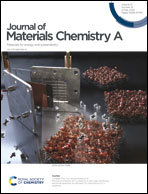Converse two-way shape memory effect through a dynamic covalent network design†
Abstract
The recently emerged thermally driven two-way shape memory effect has greatly expanded the capabilities and practical potential of shape memory polymers. Without exception, its actuation direction is reflected as cooling-induced elongation and heating-induced contraction along with the programming force. In contrast to the current knowledge, we describe here a molecular mechanism to achieve an opposite behavior in a two-way shape memory polymer (2W-SMP). The network is designed to contain two types of segments: a crystallizable polycaprolactone (PCL) and an elastic poly(butyl acrylate) (PBA). As a programming force is exerted, the stress imposed onto PCL segments is relaxed via transesterification based dynamic bond exchange. As the force is removed subsequently, the elastic recovery of the PBA chains compels the crystallizable PCL chains to align perpendicular instead of parallel to the original programming force. This results in a 2W-SMP with its actuation direction opposite to known examples. Spatiotemporal manipulation of the dynamic bond exchange via a photo-latent catalyst further allows diversifying the actuation behaviors. The resulting material with unique actuation can serve as a thermosensitive switch for high-temperature warnings. We envision that this distinctive mechanism shall diversify the gallery of SMPs and open new possibilities for fabricating smart materials.



 Please wait while we load your content...
Please wait while we load your content...